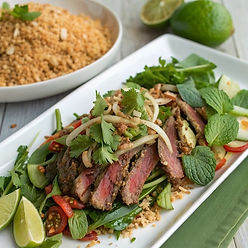Creating Authentic Texture Through Toasted Rice Powder

The judges' enthusiastic repeated praise I love that toasted rice it gives it a real crunch I love the toasted rice I think that's really smart it adds smokiness and adds great texture demonstrates how single distinctive element can elevate dish from good to memorable through authentic technique. Toasted rice powder (khao kua in Thai) is essential component of traditional waterfall salad providing three critical contributions: satisfying crunch that contrasts with tender beef and soft greens, smoky nutty flavor that can't be replicated by other ingredients, and authentic marker of proper Thai preparation showing cultural knowledge and respect. Jet's technique using cast iron skillet rather than standard pan was smart choice as cast iron's superior heat retention and even distribution create more consistent toasting without hot spots that would burn some grains while leaving others pale. The process requires patience and attention: heat dry cast iron over medium heat with no oil added, add sticky rice or jasmine rice (sticky rice is traditional but jasmine works well), stir frequently with wooden spoon ensuring all grains contact hot surface, toast for 8-10 minutes until rice reaches deep golden brown color throughout not just surface, watch carefully during final minutes as transition from golden to burnt happens quickly, and cool completely before grinding as warm rice grinds unevenly. The target color is important because pale rice lacks smoky flavor judges praised, medium golden provides some nuttiness but insufficient depth, deep golden brown creates proper smokiness and crunch, while burnt rice tastes acrid and bitter ruining dish. Grinding technique matters for texture: coarse powder with visible grain pieces provides crunch judges loved, medium grind offers subtle texture, and fine flour-like powder disappears providing flavor but losing textural impact. Spice grinder or coffee grinder gives consistent medium-coarse results, mortar and pestle allows control over final texture, and food processor works but requires careful pulsing to avoid over-grinding. The application strategy affects experience: adding rice powder before final toss distributes throughout salad, sprinkling over top before serving provides immediate crunch and visual appeal, and serving extra on side lets diners add more as they eat maintaining maximum crunch. Beyond waterfall salad, toasted rice powder appears in other Thai dishes including larb (minced meat salad), som tam variations, and certain curries, always providing signature nutty crunch and smoky depth. The technique of toasting grains or seeds to develop flavor and texture extends beyond Thai cuisine: toasted sesame seeds for Japanese dishes, toasted cumin or coriander for Indian preparations, toasted breadcrumbs for Italian pasta dishes, and toasted nuts for countless applications all demonstrate principle that dry heat transforms bland ingredient into flavorful textural element. Jet's execution earned really smart recognition because it showed both technical knowledge of authentic Thai technique and understanding that texture contrast (crunchy rice against tender beef and soft greens) creates dynamic eating experience rather than monotonous mouthfeel. For home cooks or professional chefs working with unfamiliar cuisines, identifying and properly executing these signature authentic elements like toasted rice powder demonstrates respect for tradition and elevates dish beyond superficial approximation to genuine expression earning praise from judges who recognize difference between shortcuts and proper technique.


